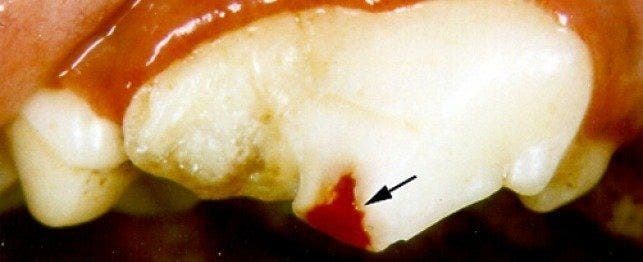
Complicated Dental (Tooth) Fractures in Dogs
Overview of Complicated Tooth Fractures in DogsDental fractures (broken teeth) are a common problem in veterinary medicine. Both dogs and cats experience these fractures at a rate of 10% to 20% of all pets. Dogs, however, not only seem likelier to sustain these types of injuries, they’re also susceptible to a wider variety of dental fractures than their feline counterparts.Fractures are often roughly classified as either complicated or uncomplicated. Due to their typical differences in cause, diagnosis and treatment, there is a separate article for uncomplicated dental fractures in dogs.Trauma is the typical cause of complicated dental fractures. The source of trauma includes the following:- Blunt trauma to the face (as when dogs are hit by hard objects during vehicular trauma, athletic events, or while engaged in police or military work)
- Trauma related to chewing (hard toys, rocks or other objects, for example)
- Falling from heights
- Rough play (among dogs, mostly) and certain training tactics (as with working dogs engaged in bite work)Military and police working dogs are especially susceptible to complicated fractures. A full 25% of these dogs will sustain fractures at some point in their careers. Most of them are presumably classified as traumatic, complicated fractures due to their higher risk profile.In dogs, the teeth that are affected most often include the upper (maxillary) canine teeth (their “fangs”) and the maxillary fourth premolars (the two largest molars) located on both sides of the upper jaw.Complicated dental fracture types include complicated crown fractures, complicated crown-root fracture, and root fractures.In complicated fractures, the tooth’s pulp cavity is exposed and its root compromised. Bleeding and pain may result. Chronic pain is typically the most significant effect. Exposure of the pulp makes the teeth susceptible to serious infection, pulp necrosis (dead tissue) and painful abscesses of these tooth roots.All breeds of dogs may suffer complicated dental fractures. Some breeds, however, may be predisposed to certain kinds of fractures due to their conformation. For example, brachycephalic (short-headed, snub-nosed) breeds of dogs may be more likely to sustain fractures of their more-prominent-than-typical fourth premolars (especially while chewing).
What to Watch For
The clinical signs of dental fractures are not always as obvious as dog owners might suppose. Indeed, most dogs don’t display any outward signs of pain, even after sustaining complicated dental fractures. Most manage to avoid detection either by chewing with the other side of their mouths or by swallowing their food whole.
Some dogs will, however, display subtle signs that something may be amiss in their mouths. The following may serve as circumstantial evidence of a complicated dental fracture:
- Messier than usual eating style (food falls outside of bowl)
- Tilting the head when eating (as if trying to chew on one side of the mouth)
- Regurgitating food (unchewed kibble comes up soon after eating)
- Moreover, owners who brush their dogs’ teeth or are otherwise able to explore their dogs’ mouths may observe one or more of the following signs:
- A missing piece of a tooth (owners are encouraged to compare it to the same tooth on the opposite side of the mouth)
- Discoloration of part or all of a tooth
- A visible crack on the surface of the tooth’s crown, particularly one that extends to the gumline and beyond.
Dogs and cats whose complicated dental fractures have led to a tooth root abscess may notice swelling on the side of the face and sometimes even open, oozing sores on the face (most commonly under the eye).
Diagnosis of Complicated Tooth Fractures in Dogs
Definitive diagnosis of complicated fractures, particularly root fractures, requires dental X-rays (always performed under anesthesia).
Many veterinarians in general practice are now equipped with digital dental X-ray capability to quickly assess the problem. Without taking X-rays, it may be impossible to fully assess the tooth’s degree of compromise, classify the fracture, and/or achieve the correct treatment.
Treatment of Complicated Tooth Fractures in Dogs
Treatment of dental fractures typically depends on their type and severity as well as the time elapsed between the fractures and their detection. As for X-rays, anesthesia is always required for these procedures.
When the pulp is exposed, as happens with most complicated fractures, veterinarians usually have only two options: extract the tooth or perform a root canal. Root canals aim to remove the affected pulp and replace it with a special material before applying a new crown that will allow the tooth to function as it did before.
Extraction, however, is similarly effective in relieving pain along with the source of infection. While extracting the tooth results in the permanent loss of a normally functioning tooth, it’s typically the most affordable option.
In some cases, as when the fracture extends into the root, extraction is the only option. But not all root fractures automatically require extraction. If it doesn’t result in a loose tooth or involve the crown, this kind of fracture may well heal on its own. However, these teeth have to be X-rayed often (every six months at least) to be sure they’re healing properly.
Veterinary Cost
The cost of dental fractures varies depending on the species, the kind of fracture and the treatment elected.
Complicated fractures that require extraction may run an owner $500 to $1,000 for a large tooth, if it’s extracted by a general practitioner (significantly more should a board-certified dentist be enlisted). However, this procedure may cost significantly less for cats.
Root canals in dogs and cats cost roughly the same as they do for humans. $1,500 to $3,000 or more is common. The canine tooth in a large dog, in particular, can be very expensive. Depending on the geographic location, a root canal performed on this tooth can cost up to $6,000.